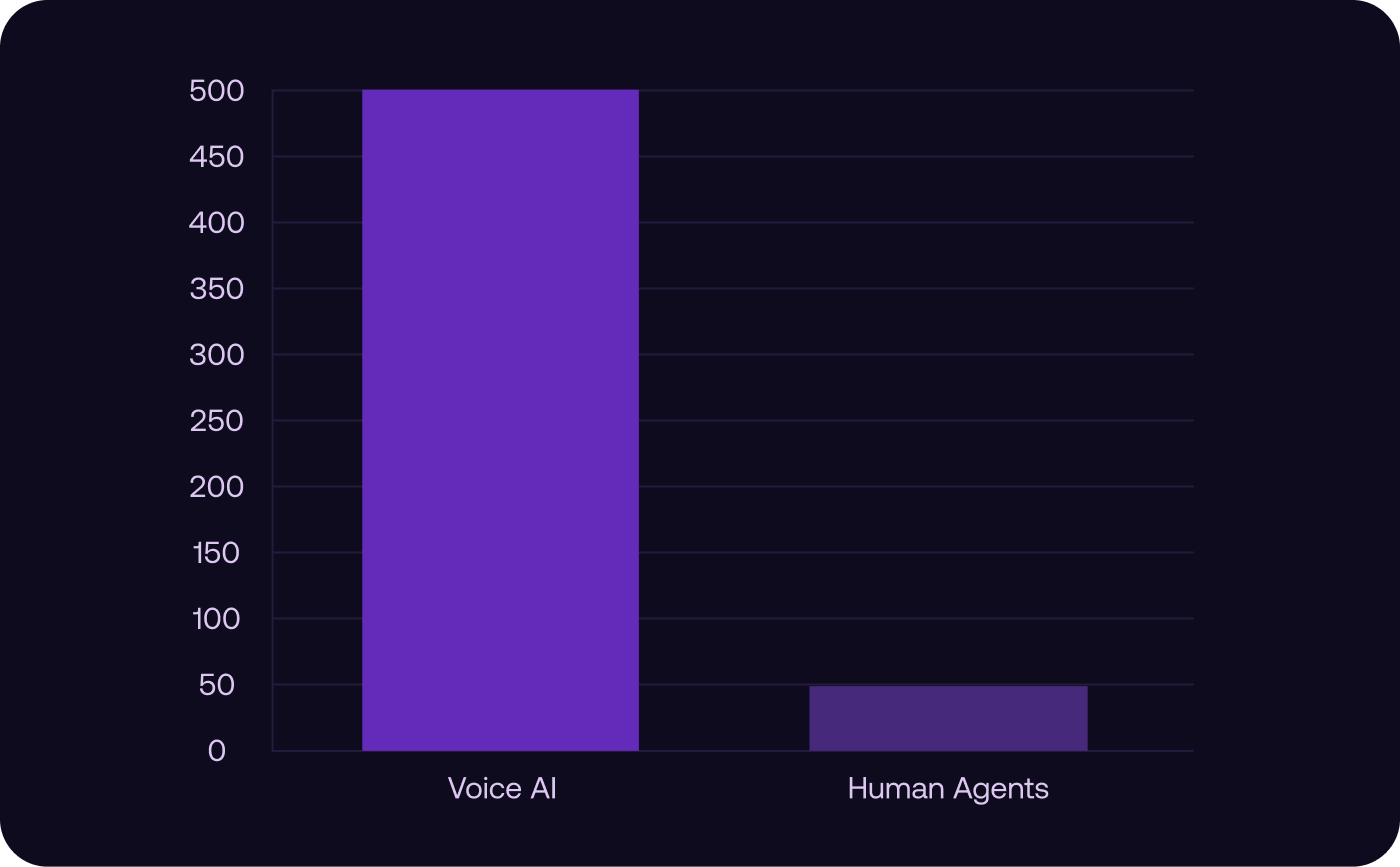I. Introduction
Overview
In the rapidly evolving landscape of sales and marketing, the integration of Voice AI is emerging as a game-changing strategy. Voice AI, a technology that leverages artificial intelligence to automate voice interactions, is becoming increasingly relevant in modern sales strategies. This article explores how incorporating Voice AI into marketing-led strategies can revolutionize sales development, offering significant advantages in predictability, scalability, and consistency.
The primary objectives of this article are to examine the transformative potential of Voice AI in sales, highlight its benefits over traditional human-led approaches, and advocate for its adoption as a digital solution to modern marketing challenges. By understanding the implications of this technology, Chief Marketing Officers (CMOs) and marketing departments can better navigate the complexities of today’s sales environment.
Importance of the Topic
For CMOs and marketing departments, maintaining a consistent brand voice and executing effective sales strategies are paramount. The growing interest in AI technologies reflects a broader shift towards digital transformation in business processes. As companies strive to stay competitive, integrating advanced tools like Voice AI is becoming crucial. This technology not only addresses common challenges in sales development but also aligns with the increasing demand for measurable and scalable solutions. Understanding the role of Voice AI in this context is essential for businesses aiming to enhance their sales performance and future-proof their operations.

II. Understanding Voice AI
Definition and Functionality
Voice AI refers to the use of artificial intelligence to generate and manage voice interactions. This technology encompasses natural language processing (NLP) and machine learning algorithms to simulate human-like conversations. In the context of sales and marketing, Voice AI automates outbound calls, handles customer inquiries, and provides information, mimicking the role of a human sales representative. By doing so, it ensures a consistent and efficient communication process.
Voice AI works by analyzing spoken language, interpreting the intent behind the words, and generating appropriate responses. This process involves several stages, including speech recognition, natural language understanding, dialogue management, and speech synthesis. These components work together to create seamless and natural-sounding interactions that can be customized to fit the specific needs and tone of a brand.
Current State of Voice AI in Sales
Voice AI is in its infancy and is just starting to gain traction. However, progressive companies are beginning to explore its potential, primarily utilizing Voice AI agents to answer phone calls and gradually replacing traditional Interactive Voice Response (IVR) technology. This shift marks the initial stages of Voice AI adoption in the business world.
In the sales and marketing arena, forward-thinking marketers and sales leaders are starting to leverage Voice AI's capabilities to enhance their processes. While still early in its deployment, Voice AI is being integrated into sales strategies to handle initial outreach, follow-up calls, and customer feedback collection. This technology is being recognized for its potential to streamline sales operations, reduce the workload on human agents, and ensure that interactions are consistent with the company's brand voice and objectives.
As businesses become more aware of Voice AI's advantages, its adoption is expected to grow, signaling a significant shift in how sales and marketing processes are managed.

III. Benefits of Integrating Voice AI into Marketing-Led Strategies
Predictability and Consistency
One of the key advantages of integrating Voice AI into marketing-led strategies is the predictability and consistency it offers. Unlike human sales calls, which can vary greatly in quality and effectiveness, Voice AI provides a uniform approach to customer interactions. This reduces human errors and ensures that every call aligns with the company's branding and messaging. The consistent delivery of information helps in building a reliable customer experience, which is crucial for maintaining a strong brand reputation.
Transforming Analog Activities into Digital Processes
Voice AI facilitates the transformation of traditionally analog sales activities into digital processes. By automating voice interactions, businesses can convert tasks that were previously manual and time-consuming into efficient, digitized operations. This digital transformation enables clear and measurable Key Performance Indicators (KPIs) to be established, offering insights into performance metrics that were difficult to track before. With Voice AI, companies can analyze data from interactions, gain actionable insights, and continuously improve their strategies based on these metrics.
Scalability
Voice AI provides unparalleled scalability for sales and marketing operations. Human resources are finite and cannot be scaled indefinitely to meet growing demands. Voice AI overcomes this limitation by allowing businesses to handle a larger volume of interactions without the need for additional human agents. This scalability means that companies can expand their outreach efforts and manage peak periods more effectively, ensuring that no customer interaction is missed due to resource constraints.

Voice AI as a Channel Similar to Email Automation
Voice AI can be managed similarly to an email automation system, providing a structured and efficient way to handle customer interactions. Just as email automation ensures that messages are sent consistently and timely, Voice AI guarantees that voice interactions maintain the same level of consistency and adherence to brand guidelines. This similarity in management allows marketers to integrate Voice AI seamlessly into their existing automation frameworks, enhancing overall efficiency and effectiveness.
IV. Addressing Challenges with Voice AI
Inability to Scale Humans Indefinitely
One of the significant challenges in traditional sales development is the reliance on human resources, which are finite and cannot be scaled indefinitely. As businesses grow, the demand for sales interactions increases, and relying solely on human agents becomes impractical. Voice AI addresses this issue by providing a scalable solution that can handle a large volume of interactions without additional human resources. This scalability ensures that businesses can meet growing demands and maintain high levels of customer engagement without compromising on quality.
Tracking and Measuring KPIs
Traditional sales development processes often struggle with tracking and measuring performance due to the analog nature of human interactions. This lack of measurable data makes it challenging for businesses to evaluate the effectiveness of their sales strategies and make informed decisions. Voice AI offers a digital alternative that allows for precise tracking and measurement of Key Performance Indicators (KPIs). With Voice AI, businesses can monitor metrics such as call duration, response rates, and customer satisfaction, providing valuable insights that can drive continuous improvement and optimization of sales strategies.
V. Counterarguments and Alternative Perspectives
Human Touch in Sales
A common counterargument against the integration of Voice AI in sales is the perceived loss of the human touch. Many believe that human interaction is crucial for building relationships and trust with customers. While this is true for certain stages of the sales process, it's important to clarify that Voice AI is intended to automate the sales development process, not the actual selling. The initial outreach, follow-up calls, and basic information dissemination can be efficiently managed by Voice AI, allowing human agents to focus on more complex and nuanced interactions where personal touch is essential. This division of labor ensures that the human touch remains integral to the most critical parts of the sales process.

Quicker Outcomes and Recipient Preferences
Another perspective is the potential preference for quicker, more efficient interactions over longer, more personalized calls. Voice AI can achieve quicker outcomes in calls, which is often appreciated by recipients who value efficiency and promptness. In many cases, customers prefer concise and direct communication, especially for routine inquiries or follow-up interactions. Voice AI can provide this level of efficiency, ensuring that customers receive timely responses without the need for prolonged conversations.
While formal case studies might be scarce due to the nascent stage of Voice AI technology, early adopters report positive feedback from customers who appreciate the prompt and consistent service. These anecdotal evidences suggest that Voice AI can enhance customer satisfaction by meeting the demand for quick and reliable communication.

VI. Implementation of Voice AI
Steps to Integrate Voice AI
Integrating Voice AI into a marketing-led strategy requires careful planning and execution. Here is a step-by-step guide to facilitate this process:
- Assess Business Needs and Objectives:
- Identify the specific areas within your sales and marketing processes where Voice AI can add value.
- Define clear objectives, such as improving call efficiency, enhancing customer experience, or scaling outreach efforts.
- Choose the Right Voice AI Platform:
- Research and select a Voice AI platform that aligns with your business requirements.
- Consider the platform's ability to work as part of a multi-channel campaign, ensuring voice interactions are not siloed but fully integrated into the overall campaign process.
- Ensure that all interactions with prospects are stored in a unified memory accessible to all channels.
- Develop a Deployment Plan:
- With platforms like Grap8, deployment can be as simple as turning on a new campaign. Integrations into existing CRMs ensure that all data is readily accessible.
- The streamlined nature of these platforms reduces the need for an extensive deployment plan, facilitating quick and efficient implementation.
- Train the AI Model:
- Customers do not need to train the model. Fine-tuning and an ongoing feedback loop based on campaign outcomes are provided by Grap8.
- Grap8's prompt engineering team handles the creation of Voice AI scripts and manages exceptions using a large, template-driven repository for clients to choose from.
- Pilot Testing:
- Conduct a pilot test to evaluate the performance of Voice AI in real-world scenarios.
- Gather feedback from prospects and internal teams to identify any areas for improvement.
- This testing phase helps optimize Voice AI outreach for the specific audience and ensures that outcomes align with the needs. Once scripts are successful, Voice AI offers the advantage of being infinitely scalable compared to human testing.
- Full-Scale Deployment:
- After refining the system based on pilot feedback, proceed with full-scale deployment.
- Monitor performance closely and make adjustments as necessary to optimize results.
- Continuous Improvement:
- Regularly update the AI model with new data and feedback from prospects to enhance its capabilities.
- Keep track of KPIs and analyze the data to continuously improve the effectiveness of Voice AI in your sales processes.
Considerations for Successful Integration
- Data Security and Privacy: Ensure that the Voice AI platform complies with data security and privacy regulations to protect customer information.
- User Training: Provide training for your team to understand how to work alongside Voice AI and leverage its capabilities effectively.
- Customer Communication: Provide full transparency to your prospects, informing them that they are interacting with a Voice AI agent and not a human. This transparency builds trust and manages expectations.
Case Studies and Expert Opinions
While formal case studies are limited due to the novelty of Voice AI, industry experts are optimistic about its potential. Leading voices in AI and marketing suggest that early adoption of Voice AI can provide a competitive edge by improving efficiency and customer satisfaction. Progressive companies are already beginning to see the benefits of integrating Voice AI, setting a precedent for broader industry adoption.
VII. Conclusion
Summary of Key Points
Integrating Voice AI into marketing-led strategies offers significant advantages for sales development, particularly in terms of predictability, scalability, and consistency. Voice AI provides a more reliable and consistent approach compared to human sales calls, reducing errors and variability in brand voice. It transforms traditionally analog activities into digital processes, allowing for clear and measurable KPIs. The scalability of Voice AI ensures that businesses can handle a larger volume of interactions without additional human resources. Additionally, Voice AI can be managed like an email automation system, ensuring consistent brand voice and execution.
Voice AI addresses the limitations of human resources in sales development and offers digital tracking and measurement capabilities, overcoming the challenges of traditional processes. While concerns about the loss of the human touch are valid, Voice AI is intended to automate the sales development process, freeing human agents to focus on more complex interactions. Quicker outcomes in calls are often appreciated by recipients, demonstrating the efficiency and effectiveness of Voice AI.
Call to Action
As Voice AI technology continues to evolve, it presents an invaluable opportunity for CMOs and marketing departments to enhance their sales strategies. By adopting Voice AI, businesses can future-proof their operations, ensuring consistent and scalable interactions that meet the demands of modern customers. CMOs and marketing leaders are encouraged to explore the potential of Voice AI, consider its integration into their strategies, and leverage its capabilities to drive efficiency and improve sales outcomes.
For those interested in taking the next steps, starting with a pilot test of Voice AI in specific areas of their sales development process can provide valuable insights and pave the way for broader implementation. Embracing Voice AI now will position businesses at the forefront of innovation, ready to capitalize on the future of sales technology.

